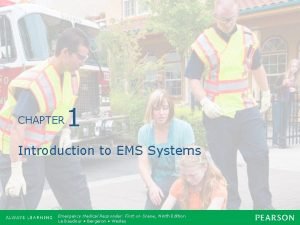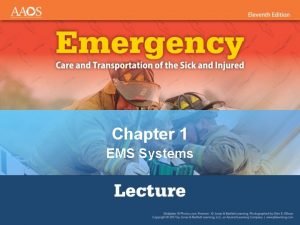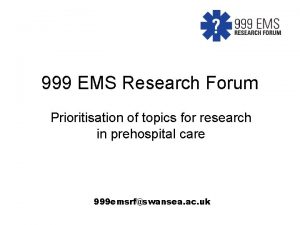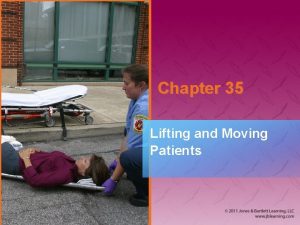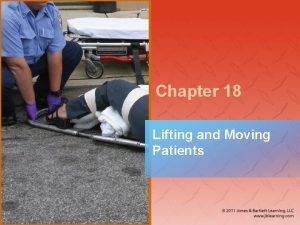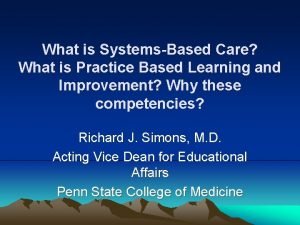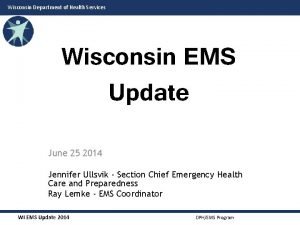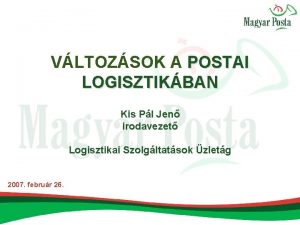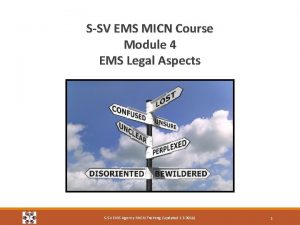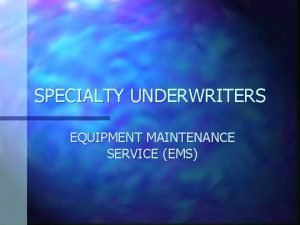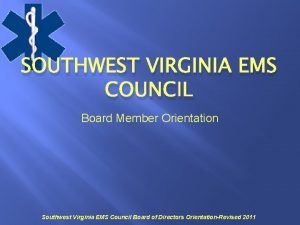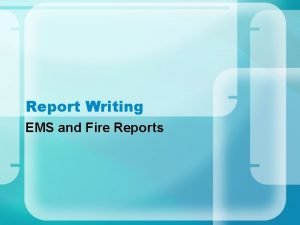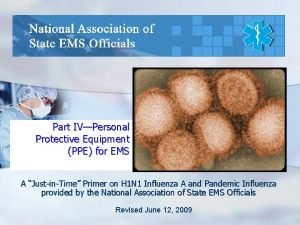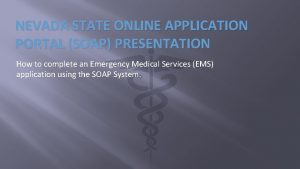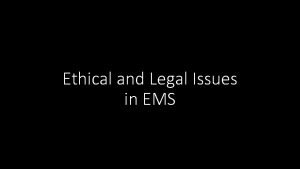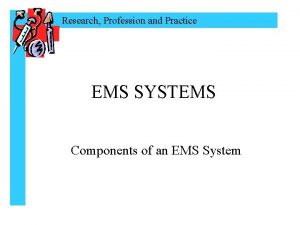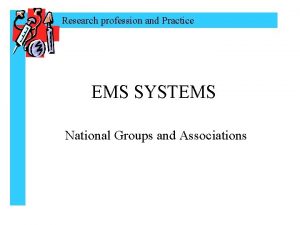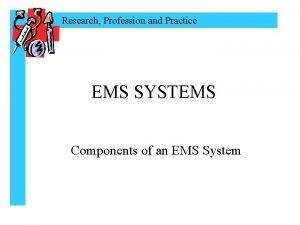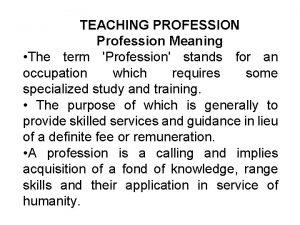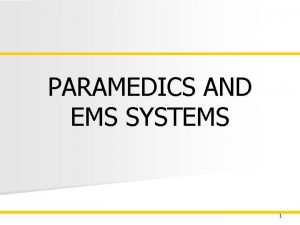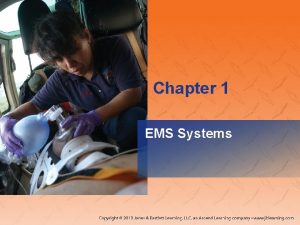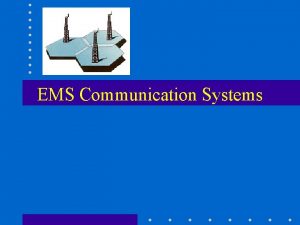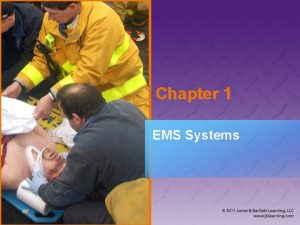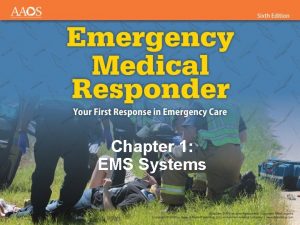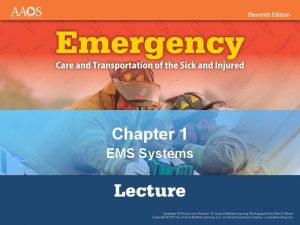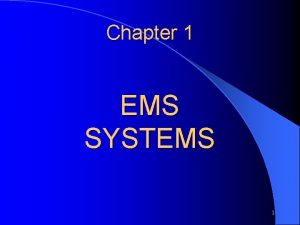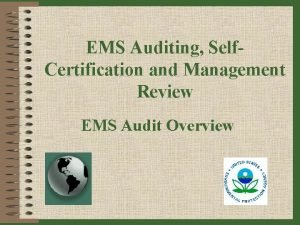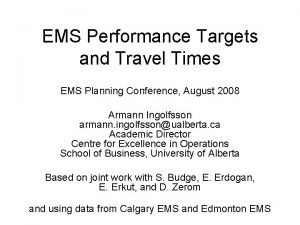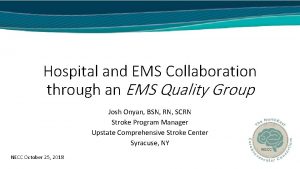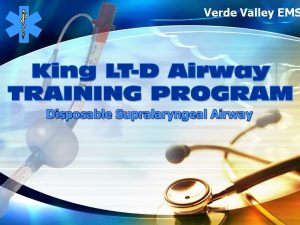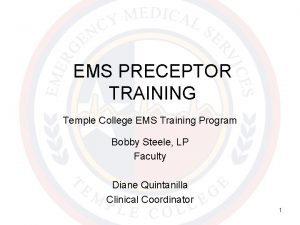Research profession and practice EMS SYSTEMS Research profession







































- Slides: 39

Research profession and practice EMS SYSTEMS

Research profession and practice Topics • History of EMS • Components of an EMS System • National Groups and Associations

Research profession and practice Today we will look at the History of EMS

Research profession and practice History

Research profession and practice History (cont’d) • Where do we start when looking at the history of EMS? • 25 years ago? • 50 years ago? • Further back still?

Research profession and practice The History of EMS and EMS systems have developed from the traditional and scientific beliefs of many cultures.

Research profession and practice Ancient Times First “protocols” established in Mesopotamia. Evidence of medications, patient assessment techniques, and bandages. During the 15 th century Crusades, special tents for the wounded called ‘ambulancias’ were prepared by King Ferdinand Queen Isabelle of Spain.

Research profession and practice th 18 and th 19 Centuries First efforts of field care developed by one of Napoleon’s surgeons, Barron Domenic-Jean Larrey, during the Austrian/Prussian conflicts in 1792. Even the American Civil War forced changes and advancements onto the medical system. Triage, a method of sorting patients by severity, was also developed during this time.

Research profession and practice

Research profession and practice

Research profession and practice

Research profession and practice th 20 Century World Wars I and II and the Vietnam and Korean conflicts resulted in great advances in patient care delivery systems including transportation and patient care procedures. Buses and taxies became ambulances and the soldiers in Korea saw the first Medevac.

Research profession and practice

Research profession and practice

Research profession and practice

Research profession and practice 1966 -US • The National Highway Safety Act established the Department of Transportation which provided grants for EMS.

Research profession and practice

Research profession and practice

Research profession and practice 1969 -US • The EMT-Ambulance program was made public. The first paramedic curriculum followed in 1977.

Research profession and practice 1971 -US • White House issues $9 million in EMS grants. • Alberta had first paramedic program.

Research profession and practice 1972 • The Department of Health, Education & Welfare funded initiatives to develop regional systems. • Kingston Paramedic Course

Research profession and practice

Research profession and practice

Research profession and practice EMS Systems Act of 1973 • Provided funding for a series of trauma projects. • $300 million was allocated to study EMS planning, operations, expansion, and research. • Continued funding for regional systems until ’ 81.

Research profession and practice To be eligible for funding a system must address: MANPOWER TRAINING COMMUNICATIONS CRITICAL CARE UNITS PUBLIC SAFETY AGENCIES CONSUMER PARTICIPATION TRANSPORTATION ACCESS TO CARE DISASTER PLANS EMERGENCY FACILITIES PATIENT TRANSFER MUTUAL AID STANDARDIZED RECORDKEEPING PUBLIC INFORMATION & EDUCATION SYSTEM REVIEW & EVALUATION

Research profession and practice Two Items the Legislation Omitted • System finance • Medical direction

Research profession and practice 1975 • Ontario had developed EMCA system • Ambulance and Emergency Care college course (AEC)- a one year program

Research profession and practice 1977 • Air Ambulance System started

Research profession and practice “Star of Life” “Just as pharmacists have the mortar and pestle and doctors have the caduceus, Paramedics and Emergency Medical Responders have a symbol in the ‘Star of Life. ’”

Research profession and practice “Star of Life” • Designed by Leo R. Schwartz, Chief of the EMS Branch, National Highway Traffic Safety Administration (NHTSA), the "Star of Life" was created after the American National Red Cross complained in 1973 that they objected to the common use of an Omaha orange cross on a square background of reflectorized white which clearly imitated the Red Cross symbol.

Research profession and practice “Star of Life” • The newly designed, six barred cross, was adapted from the Medical Identification Symbol of the American Medical Association – registered on February 1, 1977 • Each of the bars of the blue "Star of Life" represents the six system function of the EMS.

Research profession and practice “Star of Life” • The snake and staff in the center of the symbol portray the staff of Asclepias, who, according to Greek mythology, was the son of Apollo. • Asclepias was usually shown in a standing position, dressed in a long clock, holding a staff with a serpent coiled around it.

Research profession and practice “Star of Life” • The Bars in the Star of life represent the Six System Function of the EMS. – Detection – Reporting – Response – On Scene Care – Care In Transit – Transfer to Definitive Care

Research profession and practice 1960/70 s • Dr Norman Mc. Nally • Standardized system for ambulances and attendants • 1972 First Ambulance and Emergency Care course starts at Humber College with 25 students.

Research profession and practice 1981 • …the passage of the Consolidated Omnibus Budget Reconciliation Act (COBRA) wiped out federal EMS funding. • Canadian Provinces starting to look at Paramedic Programs • Ontario Pilot Program 1984 – For ACPS • EMA’s (level I to III)

Research profession and practice 1988 -Components of an EMS system • Regulation • Resources Management • Human Resources/Training • Transportation • Facilities • • • Communications Trauma Systems Public Information Medical Direction Evaluation

Research profession and practice Modern Trends • Within the last 10 years, moved from a variety of “Ambulance Services”, operated by: – Privately Managed – Hospitals – Fire Services and Municipal Governments • To more true EMS Systems

Research profession and practice 1990’s • OPALS-Ontario Advanced Life Support Study (Dr. Steele)-Ottawa • Stiell IG, Wells GA, De Maio VJ, Nesbitt L et al. Advanced Cardiac Life Support in Out-of-Hospital Cardiac Arrest. N Engl J Med 2004; 351: 647 -656 . – Two separate streams • Cardiac Arrest • Critical Care • SR/Defib – PCP version of above – Not a study

Research profession and practice 2000’s • 2000 – Colleges change to 2 year PCP program • EMCA exam – changed to Advanced EMCA to account for SR/Defib content • Downloading of ambulance services to UTM’s from other source (MOH, private or cities) • Technology advances. Computers on board ambulances, advanced airways, more meds, monitoring • 2004 –Stroke bypass (various regions) • 2007 + PTCA bypasses (Ottawa, York, TO, LDN) • 2009 Revision of DNR, Combining of BH groups • 2011 Change in ALS standards, BLS standards Deceased pt standard, • 2012 PTBO regional considering STEMI bypass for EMS
 Introduction to ems
Introduction to ems Ems systems chapter 1
Ems systems chapter 1 999 ems research forum
999 ems research forum Myeplg website
Myeplg website Decision support systems and intelligent systems
Decision support systems and intelligent systems Wheeled ambulance stretcher
Wheeled ambulance stretcher Short backboards are usually used to
Short backboards are usually used to 6-3 solving systems using elimination
6-3 solving systems using elimination Word problems inequalities worksheet
Word problems inequalities worksheet Information systems management in practice
Information systems management in practice Discovering economic systems comparative worksheet answers
Discovering economic systems comparative worksheet answers System of inequalities word problems
System of inequalities word problems Practice 3-2 solving systems algebraically
Practice 3-2 solving systems algebraically Practice 3-6 systems with three variables
Practice 3-6 systems with three variables Systems-based practice in nursing
Systems-based practice in nursing Graphing two-variable linear inequalities assignment
Graphing two-variable linear inequalities assignment What profession
What profession Teaching as a vocation mission and profession
Teaching as a vocation mission and profession Contoh e-panggilan
Contoh e-panggilan Code of conduct for teachers 2019
Code of conduct for teachers 2019 Issues and ethics in the helping profession
Issues and ethics in the helping profession Theory research and evidence based practice
Theory research and evidence based practice Theory research and evidence-based practice
Theory research and evidence-based practice Principles of complex systems for systems engineering
Principles of complex systems for systems engineering Embedded systems vs cyber physical systems
Embedded systems vs cyber physical systems Elegant systems
Elegant systems Wisconsin ems e licensing
Wisconsin ems e licensing Uc merced deferred payment plan
Uc merced deferred payment plan Ems felvételre kijelölt posták
Ems felvételre kijelölt posták Verdant thermostat
Verdant thermostat Ssv ems
Ssv ems Ems equipment repair
Ems equipment repair Southwest virginia ems council
Southwest virginia ems council Ems latlit
Ems latlit Ems report writing
Ems report writing Nbitrex
Nbitrex Nevada ems soap
Nevada ems soap Ems iso 9001
Ems iso 9001 Emsisd skyward
Emsisd skyward Oath of geneva ems
Oath of geneva ems
